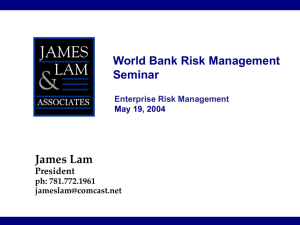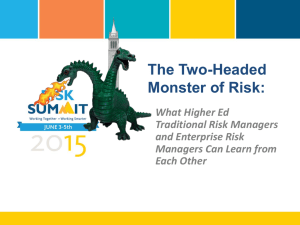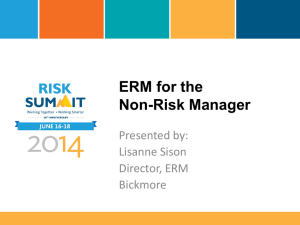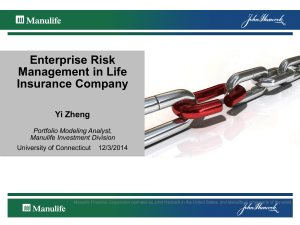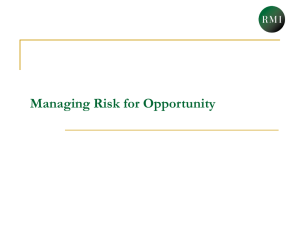Doug Webster
advertisement
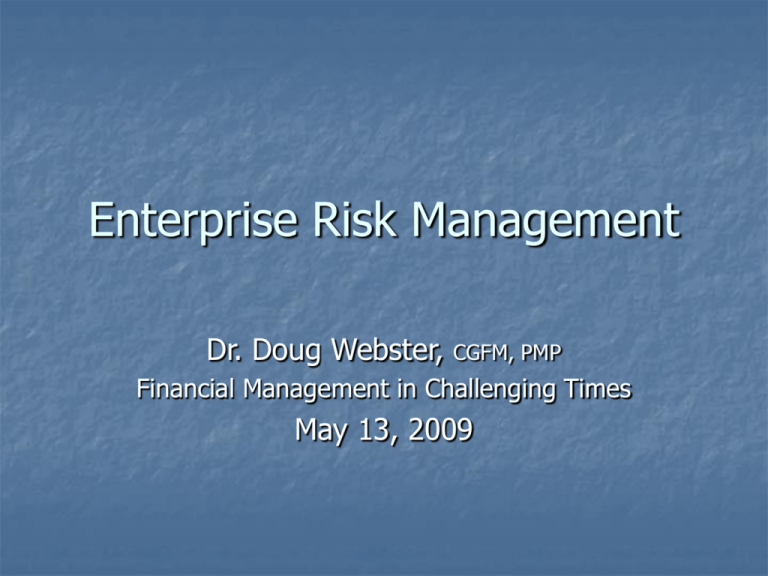
Enterprise Risk Management Dr. Doug Webster, CGFM, PMP Financial Management in Challenging Times May 13, 2009 Why Worry About Risk? One of the most commonly heard words in the news for more than a year has been: Change Those in public service are the ones who have to deal with and implement this change. But how will you plan for and react to change? A reluctance to change causes many to seek a “burning platform” Change Drives Risk The change that you internally implement in response to external change can take different forms Options Urgency and Risk Proactive Change Reactive Change Reactive Change in Crisis Managing Change = Managing Risk Managing an organization requires more than tradeoffs between costs and benefits Risk must be considered, but traditional risk management has failed us Risk management is: Often reactive and not strategically driven Typically conducted within functional silos Inconsistently applied across the organization Enterprise level change requires enterprise level risk management that overcomes these shortcomings So What is ERM? "…the discipline by which an organization in any industry assesses, controls, exploits, finances, and monitors risks from all sources for the purpose of increasing the organization's short- and long-term value to its stakeholders.” ~ Casualty Actuarial Society, Enterprise Risk Management Committee, 2003 Key Principles ERM seeks to optimize risk management across the enterprise and address the shortcomings of traditional risk management ERM is: 1. 2. 3. strategically aligned multi-functional/comprehensive consistently applied across the enterprise 1) Strategically Driven Effective risk management: 1. 2. Responds to risks external to the organization that could impact strategic goals and objectives Manages internal risks that could impede achievement of strategic goals and objectives Current risk management is not driven by the strategic planning process (which is often a compliance exercise) 2) Comprehensive IT Security IT Capital Investment Financial Reporting Functional Risk Areas ? ? Functional Area “Silos” Missed risks due to lack of ownership (risk in the “white space”*) Ignorance of impact of risk management decisions outside of the silo * Rummler, Geary A.; Alan P. Brache (1995). Improving Performance: How to Manage the White Space in the Organization Chart 3) Consistent Functional Risk Areas Portfolio-based Risk assessment and management Internal Controls COOP Budget Demographics Etc. Functional & Thematic Area “Silos” Risk management must be consistently applied across the organization (consistent risk ROI) Risks are balanced with rewards within an explicit risk tolerance Analytical: Integrational: Analysis of specific risks Evaluation of a risk portfolio Decisional: Integration of risk into business decision making Risk Portfolio Other Business Considerations (Rewards) Financial IT Security Physical Security Programmatic Etc. Stages of Risk Management Strategically Aligned Business Decisions “Risk management” personnel (actuaries, auditors, IT security specialists, etc.) } Financial IT Security Physical Security Programmatic Etc. Risk Management Stakeholders Risk Portfolio Operational management } Risk Portfolio Other Business Considerations (Rewards) Financial IT Security Physical Security Programmatic Etc. Risk Management Stakeholders Strategically Aligned Business Decisions Executive/strategic management } Risk Portfolio Other Business Considerations (Rewards) Risk Management Stakeholders Strategically Aligned Business Decisions Isn’t OMB A-123 Risk Management? Internal Control is an integral component of an organization’s management that provides reasonable assurance that the following objectives are being achieved: Effectiveness and efficiency of operations, Reliability of financial reporting, and Compliance with applicable laws and regulations. —GAO/AIMD-00-21.3.1, November 1999 ERM is much more than A-123 Difference A-123 is focused on Internal Controls ERM focuses broadly on risk management (internal and external) across the enterprise Difference #2 A-123 / Internal Control reviews look backwards ERM looks forward into the future Difference #1 #3 A-123 lacks two attributes found in current ERM Frameworks and practice: Comprehensive - covers ALL risks in an organization, not just internal controls Consistent– evaluates functional risks on a common basis across the entire organization Requirements for ERM Success Risk management is viewed as an inherent function of all management and decision making Senior leadership establishes an explicit risk tolerance, and balances risk vs. reward in terms of strategic goals and objectives Operational and executive management balances risk across functions comprehensively and consistently Risk professionals are viewed as partners in managing risk, not the “owners” of risk ERM Requires More than Risk Management…it Requires Organizational Change Management Learn and dialog: www.federalerm.com


